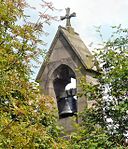 Ah, the ringing of wedding bells! A lovely, romantic sound. It always conjures in my mind true love and happily ever after. The hope of a bright future awaiting the couple probably isn’t much different now than it was centuries past. But the way people married has evolved over the years.
Ah, the ringing of wedding bells! A lovely, romantic sound. It always conjures in my mind true love and happily ever after. The hope of a bright future awaiting the couple probably isn’t much different now than it was centuries past. But the way people married has evolved over the years.
In Regency England, a couple could get married one of three ways: they could marry in a church after the reading of The Banns, they could obtain a Common License, or they could marry by Special License. They could also elope and go to Scotland, but that’s a topic for a different post.
A couple wishing to be wed in the traditional way had to have their ministers of their local parishes to read what was called “The Banns” meaning he read their names for three Sundays in a row, and also posted their names at each church for those three weeks. This was to provide anyone who knew of a good reason why they shouldn’t marry to declare it. Usually, the reason someone objected was if one of them were already married, as was the case in the book Jane Eyre. If no one objected, then the couple could marry within the next three months. The two parishes had to send written confirmation to each other that party from each parish was eligible to wed. Marriages also had to take place between 8 a.m. and noon in the parish church of the bride or the groom. They could not simply marriage in their friend’s drawing room or a garden, or other places I often see in fiction.
For those who wished to waive the reading of the banns, they could purchase a Common Marriage License, also known as a Bishop’s License. Some also probably purchased a license as a status symbol as a way of stating that they could afford the ten shillings that it cost to get a license. In order to marry by marriage license, the couple had to purchase it from the archbishops of Canterbury and York and had to swear that there was no reason why they couldn’t marry. The archbishop would also conduct his own investigation to ensure the bride and groom were both eligible to marry. Marriages by common license required the couple to marry in a church or consecrated building.
A Special License was the third option. They were more difficult to obtain and they were also costly—to the tune of four to five pounds. They were also only issued by the Archbishop of Canterbury, and only to those of high rank. A special license gave the couple the option to marry any time or place they desired. Although they were encouraged to marry in churches, the marriage could be performed anywhere such as a home or garden. Few people were eligible to marry by special license. Only peers and their children, baronets, knights, members of Parliament, Privy Councillors and Westminster Court Judges had this option.
According to Nancy Mayer, noted Regency researcher and author: Many of the upper classes married by common license rather than banns so as not to have to make a public announcement. They still had to marry in the parish church between the hours of 8 and noon but preferred not to announce it in advance to all and sundry. Those who invited or who should be informed were told in person or by letter.
Also, Under the Hardwicke Marriage Act of 1754, the bride and groom had to be 21 years old to get married unless a guardian consented to their underage marriage in order to marry using a license. However, marriage by banns after age 12 for a female and 14 for a male was considered valid because it gave people in both the groom’s and the bride’s parish the opportunity to challenge the union beforehand.
Since the father of Amesbury family in my Rogue Hearts series is the Earl of Tarrington, all the sons had the option to marry by Special License at the family county seat or wherever they wished. However, since this was a rare event, and only granted under special circumstances, none of them did.
Sources:
http://jastoryandhistory.blogspot.com/2009/03/marriage-licenses.html
http://en.wikipedia.org/wiki/Marriage_license

Hi Donna,
That was a very interesting post. Being a historical writer myself, I really enjoyed it.
Regards
Margaret
I’m glad you posted this. I did a lot of research for my story to ensure historical accuracy, but it’s nice to see another writer post and verify that I wasn’t wrong …. I still had my doubts 😉
Thanks for the post, I really enjoyed it.
Always a pleasure to read your work!
Always interesting. I wonder how many girls got married at 12? Yikes!